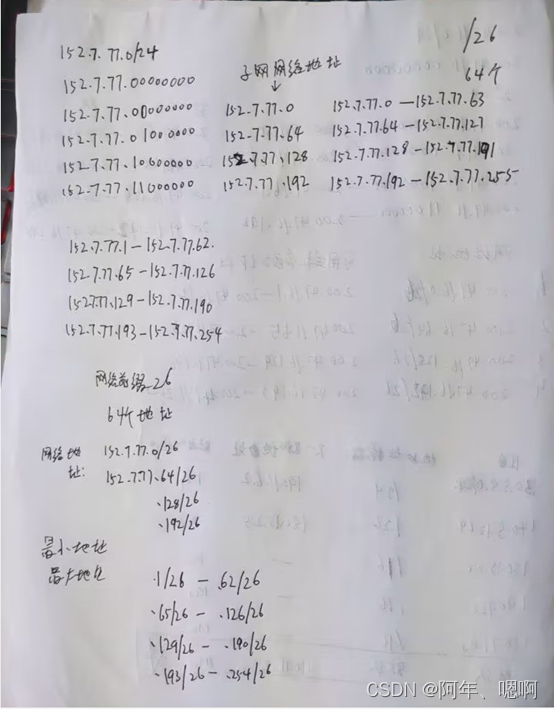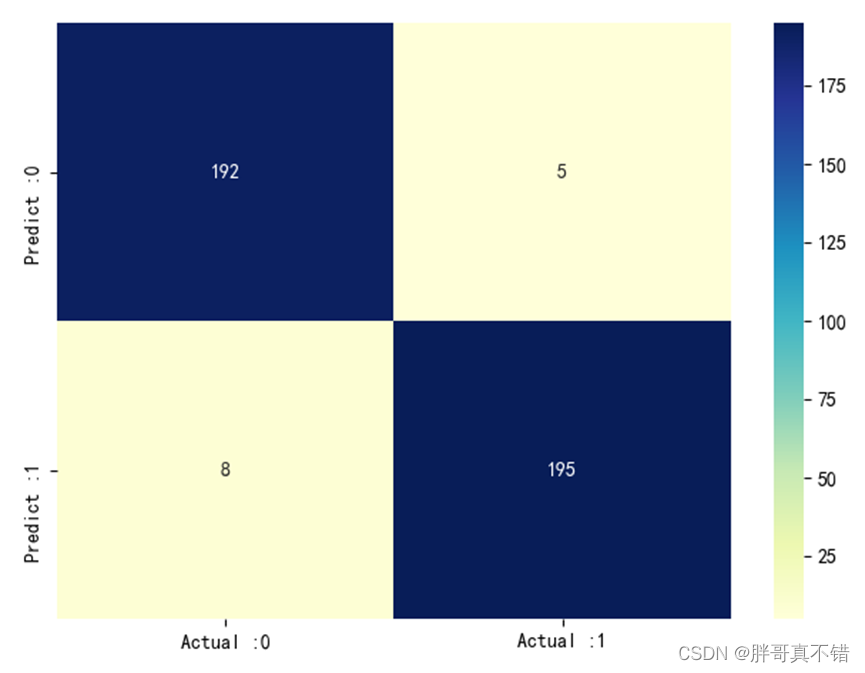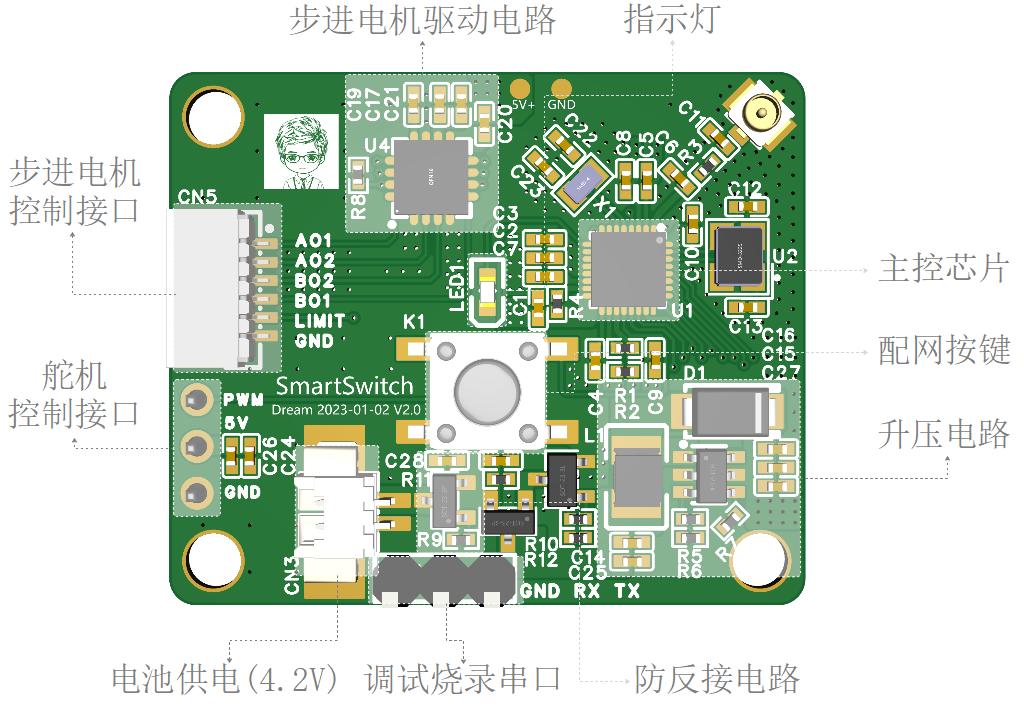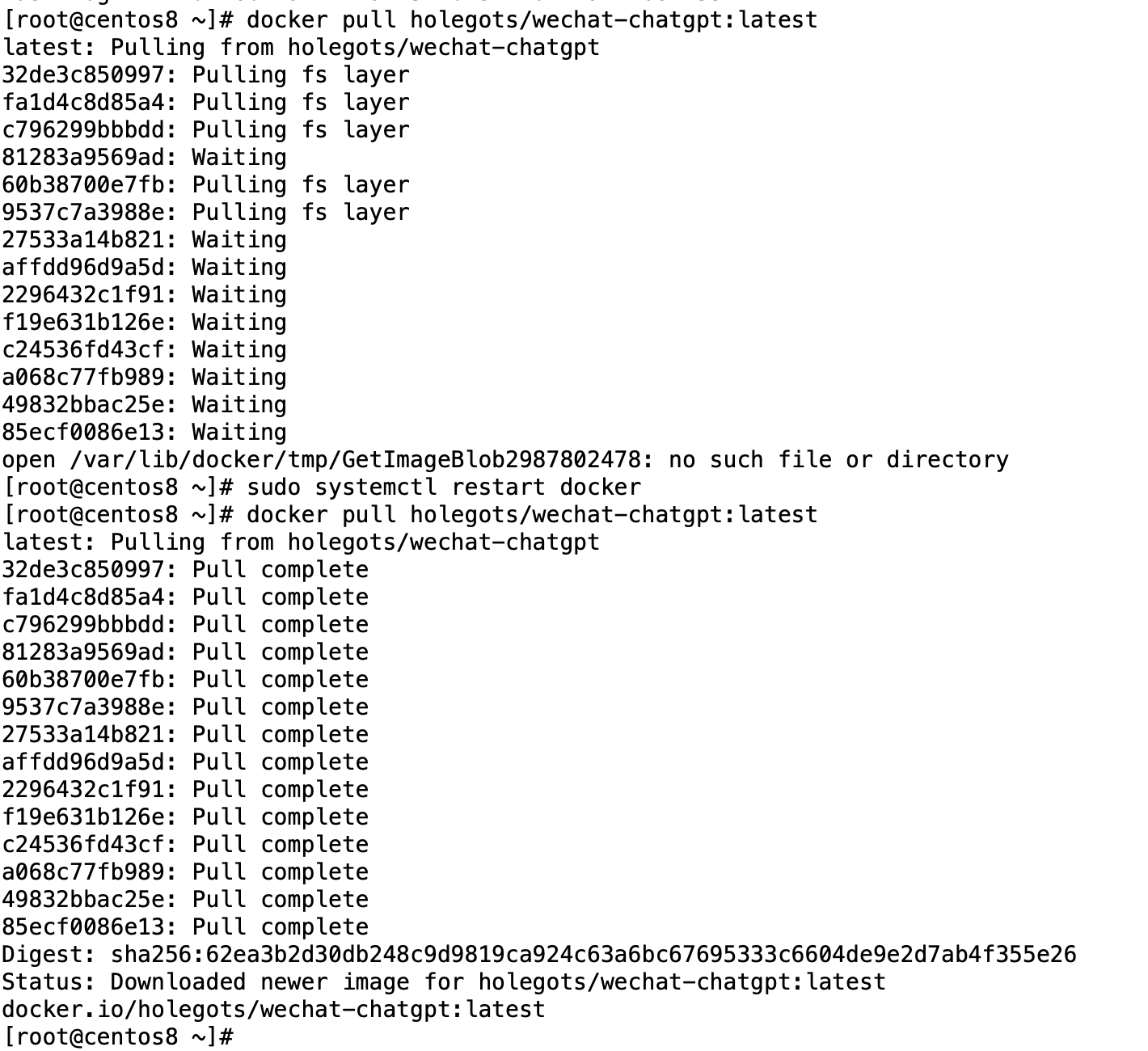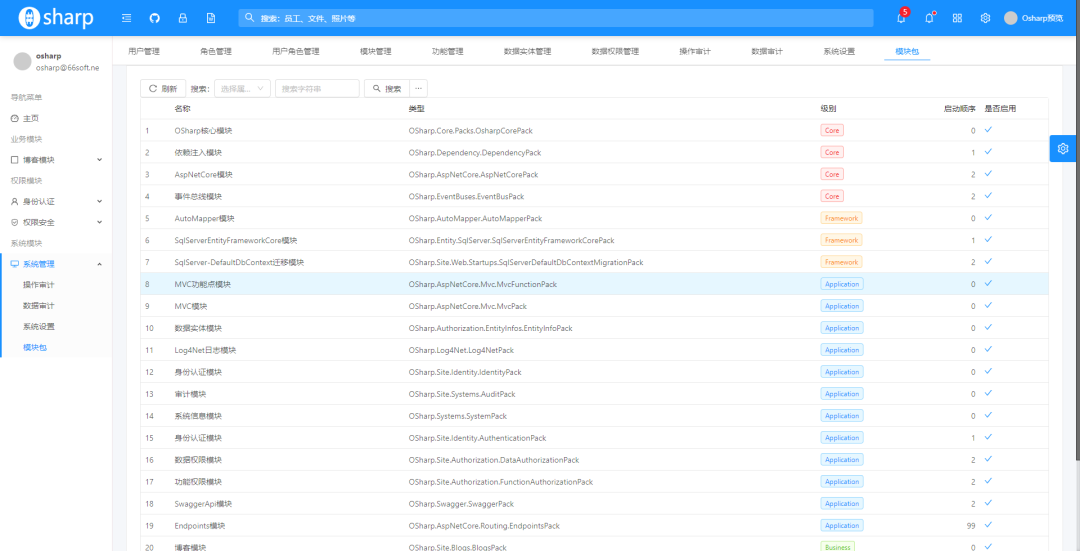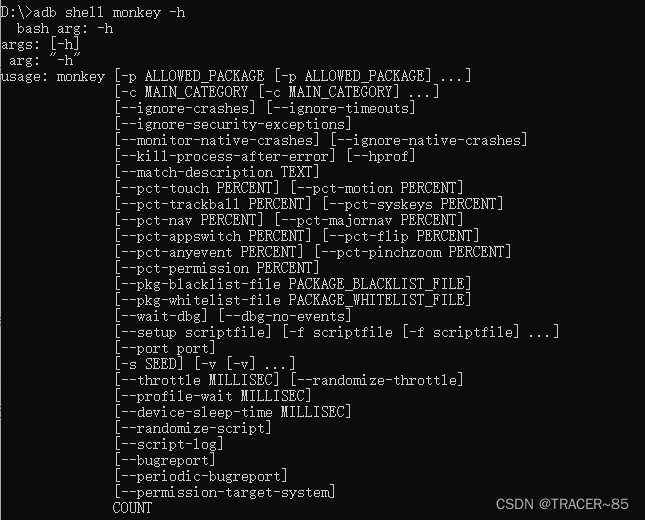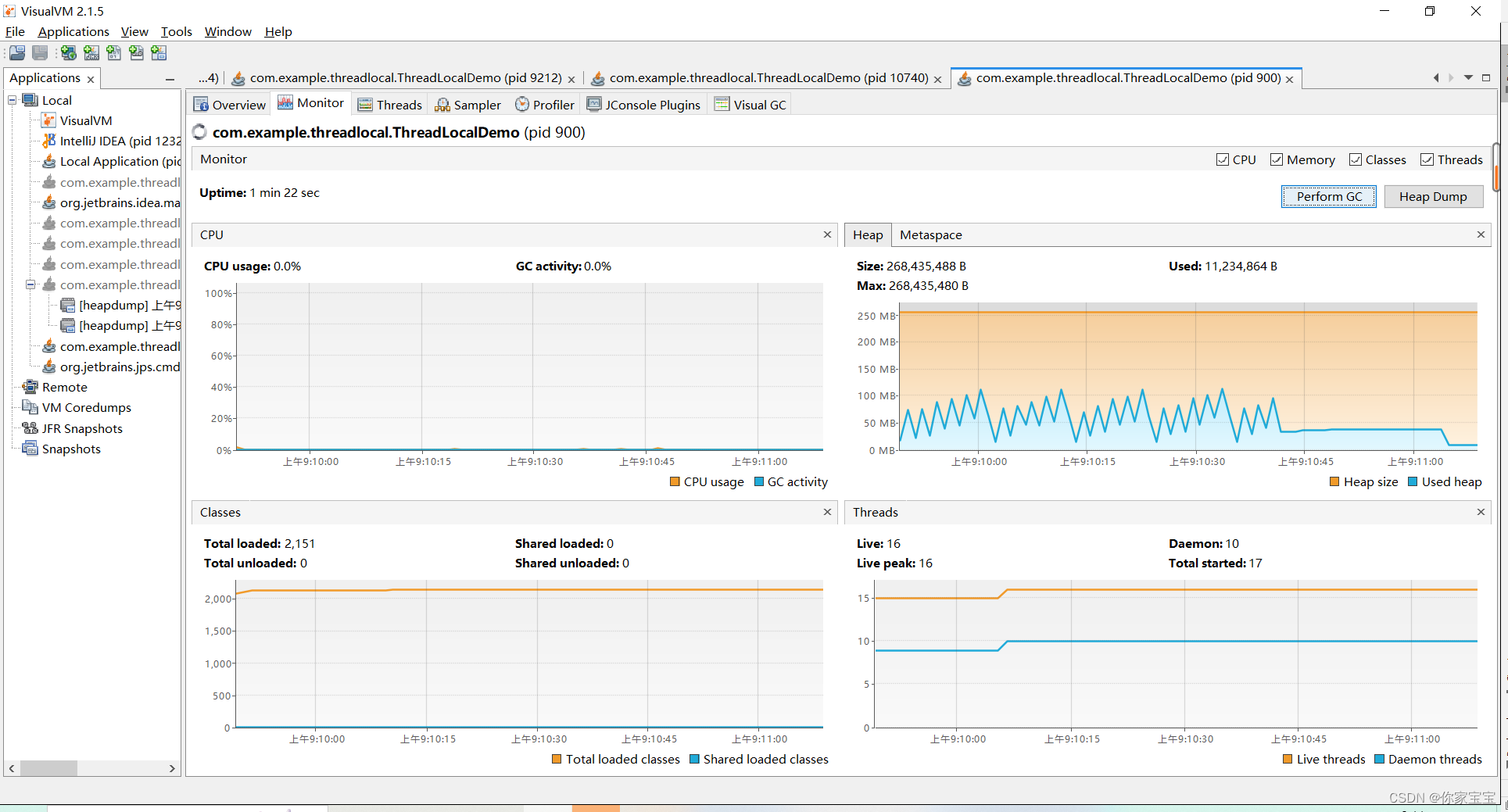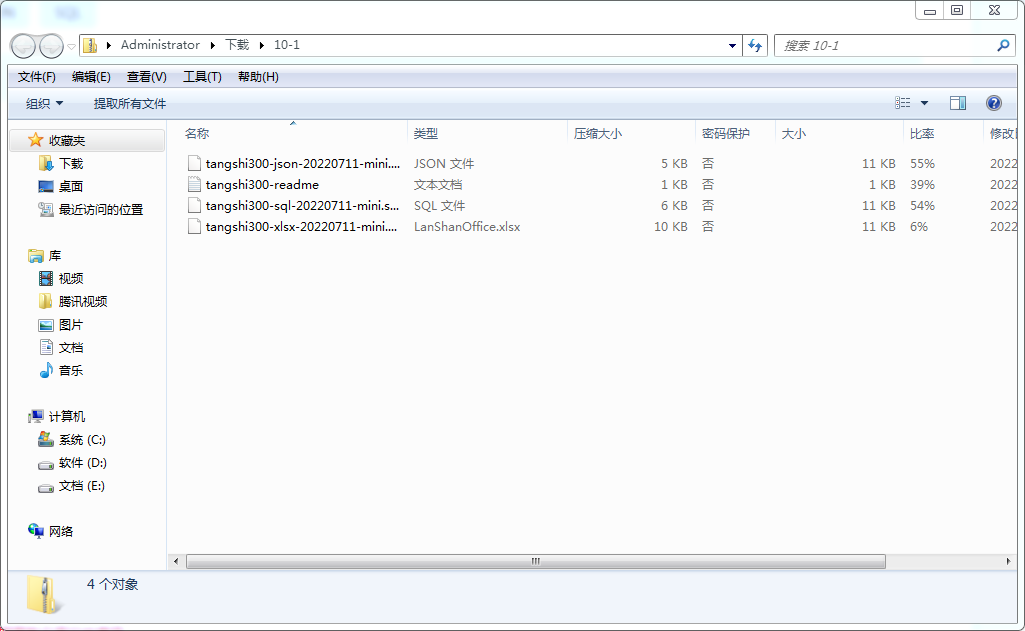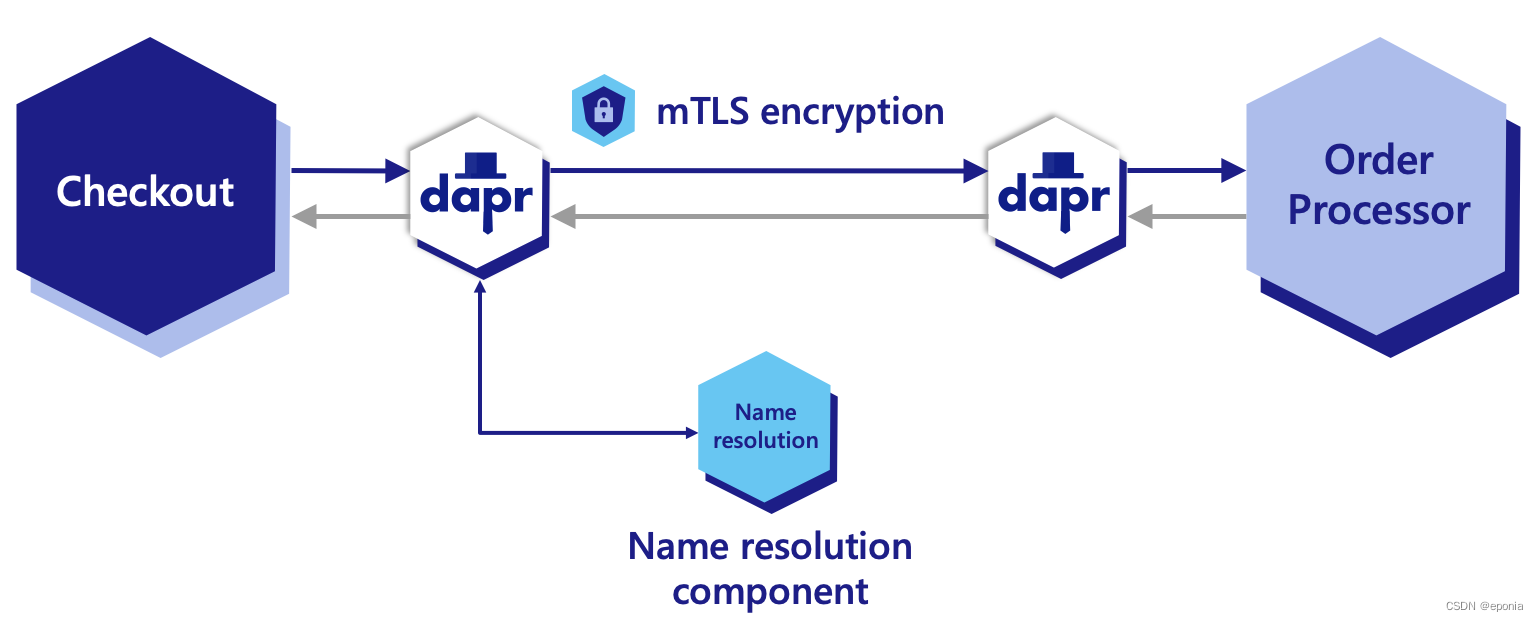文章目录
- 三、shell条件测试
- 3.1条件测试的基本语法
- 3.2 文件测试表达式
- 3.3字符串测试表达式
- 3.4 整数测试表达式
- 3.5 逻辑操作符
三、shell条件测试
为了能够正确处理Shell程序运行过程中遇到的各种情况,Linux Shell提供了一组测试运算符。通过这些运算符,Shell程序能够判断某种或者几个条件是否成立。条件测试在各种流程控制语句,例如判断语句和循环语句中发挥了重要的作用,所以,了解和掌握这些条件测试是非常重要的。
3.1条件测试的基本语法
在shell程序中,用户可以使用测试语句来测试指定的条件表达式的条件的真或假。当指定的条件为真时,整个条件测试的返回值为0;反之,如果指定的条件为假,则条件测试语句的返回值为非0值。
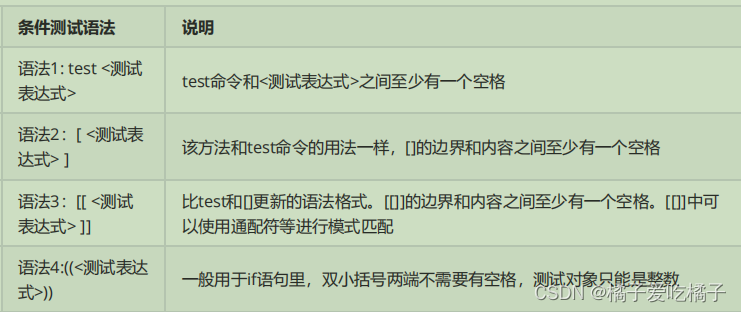
3.2 文件测试表达式
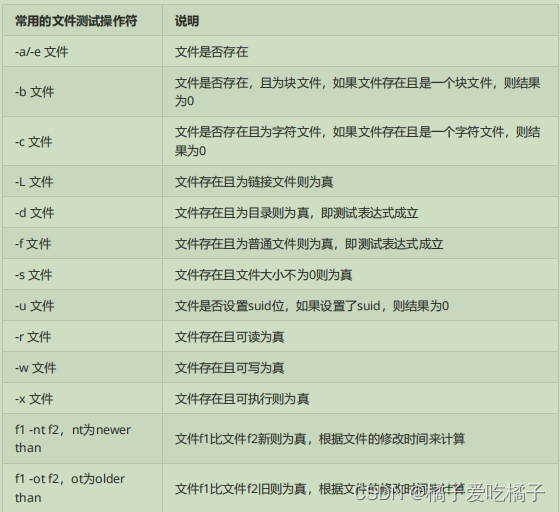
测试文件的读、写、执行等属性,不光是根据文件属性rwx的标识来判断,还要看当前执行测试的用户是否真的可以按照对应的权限操作文件。
①test示例:
[root@localhost test3]# ll
total 0
-rw-r--r--. 1 root root 0 Feb 20 10:35 file
[root@localhost test3]# test -f file;echo $?
0
[root@localhost test3]# test -f file1;echo $?
1
[root@localhost test3]# test -x file;echo $?
1
②[]示例(注意测试表达式和方括号两边需要有空格)
[root@localhost test3]# ll
total 0
-rw-r--r--. 1 root root 0 Feb 20 10:35 file
[root@localhost test3]# [ -f file ];echo $?
0
[root@localhost test3]# [ -f file1 ];echo $?
1
[root@localhost test3]# [ -w file ];echo $?
0
③[[]]示例(注意测试表达式和[[]]两边需要有空格)
[root@localhost test3]# ll
total 0
-rw-r--r--. 1 root root 0 Feb 20 10:35 file
[root@localhost test3]# [[ -f file ]];echo $?
0
[root@localhost test3]# [[ -f file1 ]];echo $?
1
[root@localhost test3]# [[ -x file ]];echo $?
1
注意:如果测试的文件路径是用变量来代替,变量一定要加引号
[root@localhost test3]# echo $filepath 该变量值为空
[root@localhost test3]# test -f $filepath;echo $?
0
[root@localhost test3]# test -f "$filepath";echo $?
1
练习1:让用户输入一个文件名,并做如下判断:
(1)如果用户输入的文件为空时显示:you must input a filename,并中断程序;
(2)如果用户输入的文件不存在时,显示the file do not exist,并中断程序;
(3)如果文件存在,判断该文件的文件类型和执行者对该文件所拥有的的权限。
说明:由于root在很多权限的限制上面都是无效的,所以使用root执行这个脚本时,常常会发现与ls -l的结果不相同。所以建议使用一般用户来执行这个脚本。
read -p "input a filename:" filename
test -z $filename && echo "you must input a filename" && exit 0
test ! -e $filename && echo "the file $filename do not exist" && exit 0
test -f $filename && filetype="regulare file"
test -d $filename && filetype="directory"
test -r $filename && perm="readable"
test -w $filename && perm="$perm writable"
test -x $filename && perm="$perm executable"
echo "the $filename is a $filetype"
echo "and the permissons are: $perm"
3.3字符串测试表达式
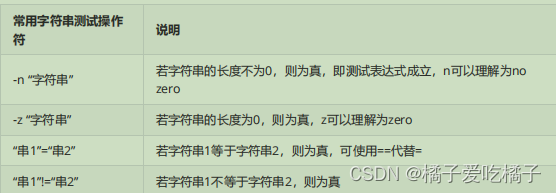
①test示例
[root@localhost test3]# test -n abc;echo $?
0
[root@localhost test3]# test -n "";echo $?
1
[root@localhost test3]# test -n " ";echo $?
0
[root@localhost test3]# test -z '';echo $?
0
[root@localhost test3]# test -z abc;echo $?
1
[root@localhost test3]# test -z ' ';echo $?
1
[root@localhost test3]# test abc = abcd ;echo $? #注意等号两边需要有空格
1
[root@localhost test3]# test abc=abcd ;echo $?
0
②[]示例
[root@localhost test3]# [ -n '' ];echo $?
1
[root@localhost test3]# [ -n ' ' ];echo $?
0
[root@localhost test3]# [ -z '' ];echo $?
0
[root@localhost test3]# [ abc=abcd ];echo $?
0
[root@localhost test3]# [ abc = abcd ];echo $? #注意等号两边需要有空格
1
③[[]]示例
[root@localhost test3]# [[ -n abc ]];echo $?
0
[root@localhost test3]# [[ -n ' ' ]];echo $?
0
[root@localhost test3]# [[ -n '' ]];echo $?
1
[root@localhost test3]# [[ abc=acd ]] ;echo $?
0
[root@localhost test3]# [[ abc = acd ]] ;echo $? #注意等号两边需要有空格
1
注意:测试对象是变量时,变量需要加引号
[root@localhost test3]# test -n $name;echo $?
0
[root@localhost test3]# test -n "$name";echo $?
1
[root@localhost test3]# [ -n $name ];echo $?
0
[root@localhost test3]# [ -n "$name" ];echo $?
1
3.4 整数测试表达式
**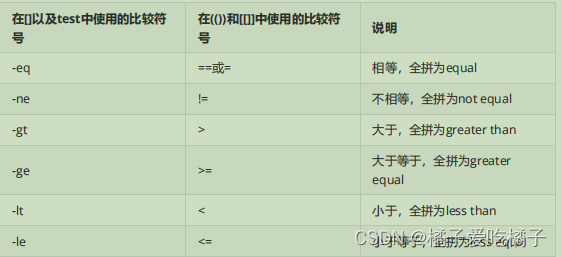
注意:
=和!=也可在[]中作比较时使用,在[]中也可使用>和<符号,但需要使用反斜线转义,有时不转译虽然语
法不会报错,但是结果可能会不对;
在[[]]中也可使用包含-gt和-lt的符号,不建议使用;
比较符号两端也要有空格。
①test示例
[root@localhost test3]# test 2 -eq 3;echo $?
1
[root@localhost test3]# test 2 -eq 2;echo $?
0
②[]示例
[root@localhost test3]# [ 2 -ne 3 ];echo $?
0
[root@localhost test3]# [ 2 -ne 2 ];echo $?
1
③[[]]示例
[root@localhost test3]# [[ 2 != 3 ]];echo $?
0
[root@localhost test3]# [[ 2 != 2 ]];echo $?
1
[root@localhost test3]# [[ 2!=2 ]];echo $? 未写空格,导致出错
0
④(())示例
[root@localhost test3]# (( 2!=3 ));echo $?
0
[root@localhost test3]# ((2!=3));echo $?
0
[root@localhost test3]# ((2=3));echo $?
-bash: ((: 2=3: attempted assignment to non-variable (error token is "=3")
1
[root@localhost test3]# ((2==3));echo $?
1
[root@localhost test3]# ((2>3));echo $?
1
[root@localhost test3]# ((2<3));echo $?
0
3.5 逻辑操作符

①test示例
[root@localhost test3]# ll
total 0
drwxr-xr-x. 2 root root 6 Feb 20 11:47 ceshi
-rw-r--r--. 1 root root 0 Feb 20 10:46 file
[root@localhost test3]# test -f file && echo 1 ||echo 0
1
[root@localhost test3]# test -f file1 && echo 1 ||echo 0
0
[root@localhost test3]# ! test -f file;echo $?
1
注:
命令1 && 命令2,如果命令1执行不成功,则命令2不执行。
命令3 || 命令4,如果命令3成功,不执行命令4;如果命令3不成功,则执行命令4
②[]示例
[root@localhost test3]# [ -f ceshi -a -f file ];echo $?
1
[root@localhost test3]# [ -e ceshi -a -f file ];echo $?
0
[root@localhost test3]# [ -f ceshi -o -f file ];echo $?
0
[root@localhost test3]# [ -f ceshi ];echo $?
1
[root@localhost test3]# ! [ -f ceshi ];echo $?
0
[root@localhost test3]# [ ! -f ceshi ];echo $?
0
使用&&等符号的错误示例:
[root@localhost test3]# [ -f ceshi && -f file ];echo $?
-bash: [: missing `]'
2
[root@localhost test3]# [ -f ceshi || -f file ];echo $?
-bash: [: missing `]'
-bash: -f: command not found
127
使用&&等符号的正确示例:
[root@localhost test3]# [ -f file ] && [ -f ceshi ];echo $?
1
[root@localhost test3]# [ -f file ] || [ -f ceshi ];echo $?0
[root@localhost test3]# [ -f file ] || [ -d ceshi ];echo $?
0
③[[]]示例
[root@localhost test3]# [[ -f file && -f ceshi ]];echo $?
1
[root@localhost test3]# [[ -f file || -f ceshi ]];echo $?
0
[root@localhost test3]# [[ -f file && -d ceshi ]];echo $?
0
④(())示例
[root@localhost test3]# ((2>3&&3>4));echo $?
1
[root@localhost test3]# ((2<3&&3<4));echo $?
0
实验1:通过read传入一个数字,如果传入的数字等于1,就打印1;如果等于2,就打印2,如果不等于1也不等于2,就提示输入不对,然后退出程序。
[root@localhost test3]# cat ./1.sh
#!/bin/bash
read -p "please input a number:" num
[ "$num" -eq 1 ] && {
echo 1
exit 0
}
[ "$num" -eq 2 ] && {
echo 2
exit 0
}
[ "$num" -ne 1 -a "$num" -ne 2 ] && {
echo error
exit 0
}
[root@localhost test3]# ./1.sh
please input a number:3
error
[root@localhost test3]# ./1.sh
please input a number:1
1
[root@localhost test3]# ./1.sh
please input a number:2
2
实验2:通过read读入两个整数,并比较他们的大小
[root@localhost test3]# cat 2.sh
#!/bin/bash
read -p "please input two number:" a b
[ -z "$a" -o -z "$b" ] && {
echo "please input 'two' number"
exit 1
}
expr $a + 10 &>/dev/null
return_a=$?
expr $b + 10 &>/dev/null
return_b=$?
[ "$return_a" -eq 0 -a "$return_b" -eq 0 ] || {
echo "please input two 'number'"
exit 2
}
[ "$a" -lt "$b" ] && {
echo "$a < $b"
exit 0
}
[ "$a" -eq "$b" ] && {
echo "$a = $b"
exit 0
}
[ "$a" -gt "$b" ] && {
echo "$a > $b"
exit 0
}
[root@localhost test3]# ./2.sh
please input two number:2 4
2 < 4
[root@localhost test3]# ./2.sh
please input two number:6 6
6 = 6
实验3:假设执行一个可以携带参数的script,执行该脚本后屏幕会显示如下的数据:
程序的文件名;共有几个参数;若参数的个数小于2个则告知用户参数数量太少;全部的参数内容;第一个参数;第二个参数。
echo "the script name is $0"
echo "the parameter number is $#"
[ "$#" -lt 2 ] && echo "the number of parameter is less than 2." && exit 0
在方括号内的每个组件都需要由空格键来分隔(特别注意中括号的两端需要有空格符来分隔);在方括号内的变量,最好都要以双引号括起;在方括号内的常量最好都以单或双引号括起来。(中括号的使用方法与test几乎一模一样)
echo "your whole parameter is '$@'"
echo "the 1st parameter is $1"
echo "the 2nd parameter is $2"
特殊条件测试表达式案例:
[ 条件1 ] && {
命令1
命令2
命令3
}
[[ 条件1 ]] && {
命令1
命令2
命令3
}
test 条件1 && {
命令1
命令2
命令3
}
if [ 条件1 ]
then
命令1
命令2
命令3
fi

